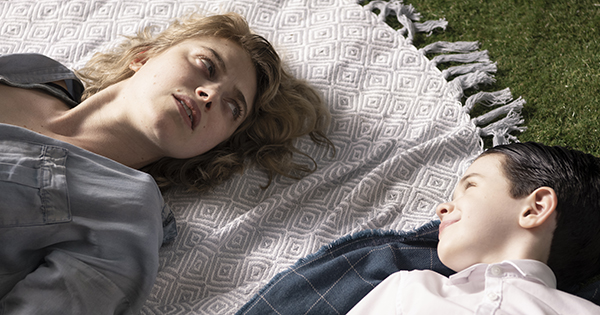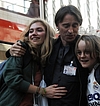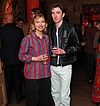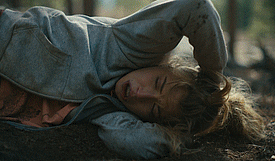‘Vivarium’ nails the feeling of social isolation. Its creators never expected it to feel so real

Lorcan Finnegan’s “Vivarium,” a fever dream about a suburban hellscape, offers a terrifying portrait of a young couple slowly unraveling under the crushing weight of social isolation.
The director had no idea how prescient the film would seem upon its release at the height of the global coronavirus outbreak, with shelter-in-place and stay-at-home orders rendering neighborhoods across the globe eerily desolate.
“It’s very strange, very surreal and weirdly creepy,” said Finnegan by phone from Dublin. “I don’t know if it’s something we should capitalize on, but people have been messaging me saying that they loved it and the experience was more intense with what’s going on outside.”
Imogen Poots and Jesse Eisenberg star as Gemma and Tom, a young couple looking to buy their first home together. After being persuaded by an eccentric Realtor to check out a new housing development, they become trapped in a perverse yet idyllic suburb with free reign to walk the silent labyrinthine streets, but with nowhere to go.
As the coronavirus crisis escalated and movie theaters shut down, the planned March 27 theatrical run for “Vivarium” was scrapped. But it proceeded with a simultaneous video on demand release, and viewers can now watch the film, which premiered at last year’s Cannes Film Festival, in their own homes.
“It’s pretty bizarre that the movie is coming out alongside this pandemic,” said Poots by phone from England. “It’s kind of [about] the psychosis of two people being fully trapped in their home. And alongside that, they’ve been cut off from society and therefore from their responsibilities and identities. I think all of that is something that a lot of people are feeling.”

From left, Imogen Poost as Gemma and Senan Jennings as The Boy in the thriller “Vivarium,” a Saban Films release.
“Movies are always going to be filtered through the period in which they’re released rather than the period in which they’re made,” said Eisenberg. “And so this movie in some way then looks like a reaction to the kind of claustrophobia, boredom and insanity that accompanies isolation, which we’re all experiencing now.”
“What we have right now is this sort of strange realm, which is like a miasma that we’re all living in,” Poots added. “Hysteria is a very contagious feeling and I think the perennial issue is that none of us have the end in sight yet. It just seems unknowable.”
The actress was in New York when the government began issuing shelter-in-place orders but quickly made the decision to return to England to be closer to family and friends.
“I’m just taking it day by day and using this time to read all the books I wanted to read, watch all the movies and TV shows I haven’t watched and call all the people I’ve been meaning to call back for the past 10 years,” she said. “And cooking with some pretty nifty use of suspicious ingredients.”
Finnegan, who is quarantined in his native Ireland, says he has been passing the time baking, gardening and developing future film projects.
“It’s very hard to plan anything because even in six months time, we don’t really know if we’ll be able to shoot the next projects,” he said. “But I’ve raised five [flower] beds and a greenhouse. And I just made a 10-second experimental film, basically a 360-degree pan of my living room broken down into every angle and then reassembled in a 3-D space like a Cubist experiment.”
And Eisenberg has spent the duration of the quarantine in an RV heading to Indiana to volunteer alongside his wife at a domestic violence shelter.
“I’m totally quarantined but moving at all times,” he said. “So we probably have a very different experience than most people. In some ways I’ve had the most active quarantine one could have because I’m driving for hours a day and I’ve definitely seen more [of the country] than I’ve ever seen in my life. … That said, I have not seen another human being or touched anything another human being has touched. But I’m with my wife and son so I don’t really feel alone.
“I think you realize how many brief social interactions you take for granted, like just passing people on the street,” he added. “We don’t value the unconscious joy it brings us to pass another person on the street because it’s never at the forefront of our mind and of course we’re so used to it. But when it’s missing, you notice.”
Although the film seems perfectly attuned to our current state of global isolation, Finnegan was originally inspired by the sociopolitical effects of Ireland’s housing boom in the Celtic Tiger, a period of rapid economic growth swiftly followed by a property bubble and severe economic downturn. (The period is also the subject of his 2011 short film “Foxes.”)
“A lot of these massive housing developments were springing up around the country and subsequently when the economy crashed in 2008 there were a lot of abandoned places left around,” he said.
“Sometimes there’d only be one or two people living alone in these massive housing developments, unable to sell their houses because nobody wanted them and banks weren’t giving mortgages to anybody anyway. So they were kind of trapped there financially, and emotionally isolated.”
The suburbs have been a familiar setting in horror and thriller movies since the ‘70s when films like “The Stepford Wives,” “Carrie,” “Poltergeist” and “Halloween” sought to upend ideals of suburban perfection. But modern-day suburbs are far more nefarious, Finnegan says, because of how they have evolved alongside our increasingly consumerist-driven society.
“I think the postwar suburbs that sprang up across America were quite socialist and a good thing for society,” he said. “But there is a kind of secondary suburb that sprang up in the past 20 years or so which are more about capitalist greed. Where they will take an area of land, sometimes beautiful and where biodiversity is important, and mill it all down and cover it in concrete then try to squeeze in as many houses as possible and advertise it heavily as aspirational to young couples. Those suburbs freak me out a little bit.”
“Vivarium,” the word itself a synonym for terrarium, opens with a montage illustrating the evolution of the European cuckoo, a brood parasitic species whose life cycle closely mirrors the film’s plot.
“A cuckoo will land in [another bird’s] nest, either eat one of their eggs or throw the egg out and then lay an egg that looks exactly like the other bird’s, matching the speckling and everything, and then they’ll fly off,” said Finnegan. “The egg is preprogrammed to hatch before the other birds’ and while the chick is still blind, it’ll push the other eggs or chicks out of the nest and mimic the sound of lots of little birds wanting to be fed. And the parents don’t notice that they’ve been duped, they just keep feeding and feeding this bird until it flies off and repeats the process.
“That was the monster that we created for this film, this estate agent who is representative of that kind of capitalist greed and conformity where they just give people what it appears that they want. They give people a house and garden but they have no ability to understand humanity or the emotional needs of people.”
Although the fate of Finnegan’s future projects remains unknown, the director says he’s optimistic about how Hollywood will fare in the near future.
“There was entertainment before the Spanish flu and there’s been entertainment afterwards,” he said. “It’ll always exist. But the landscape will have changed and certain sci-fi may be diminished by reality and not seem so fantastical after all of this, so it’ll be interesting.
“I think people are creative and inventive so it’ll be OK. But it might take a while and it’ll be a different world that we’re making films for.”
“There’s a really funny Onion headline that I’m reminded of,” said Eisenberg. “It said something along the lines of ‘Hollywood refuses to produce new movies until public watches ones they’ve already made.’ I’m concerned for the people who will lose their jobs, but I’m sure the industry as a whole will bounce back or find a different way.”





















Recent Comments